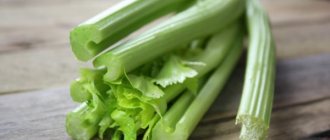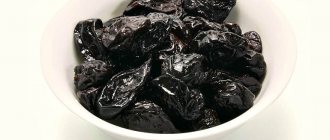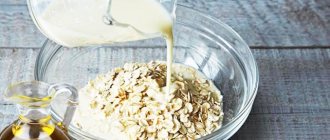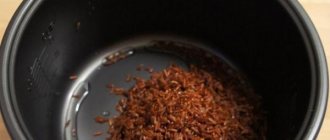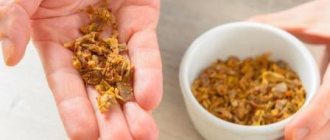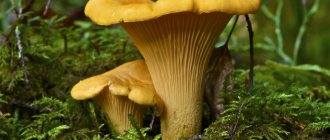Chemical composition
Root
The root vegetable contains potassium, calcium, manganese, magnesium, iron, copper, silicon, phosphorus and sulfur. Has the ability to accumulate selenium. Parsnips are also rich in furocoumarins – bergapten, xanthotoxin and sphondin. The plant has a spicy odor due to the presence of heptyl, hexyl and octyl-butyl esters of butyric acid. Parsnip roots also contain carotene, starch, pectins, vitamins and sugars.
Nutritional value of parsnip root per hundred grams of fresh product: 9.2 g of carbohydrates, 1.4 g of proteins, 0.5 g of fat. The calorie content of the vegetable is 47 kcal/100g.
Leaves
Parsnip greens contain heterocyclic compounds of the furocoumarin series - pastanacin, pasternoside, hyperin and rutin.
Composition and calorie content
The benefits of parsnips are due to the presence of a rich composition of microelements and vitamins. It contains carbohydrates, starch, B vitamins (B1, B9, B2), ascorbic acid, fiber, pectin, fatty acids, fructose, sucrose.
Parsnips contain zinc, magnesium, phosphorus, and potassium. The content of thiamine and carotene in this plant is higher than in carrots.
This is a low-calorie vegetable - 100 grams of parsnips contain only 47 calories.
Photo
In the photo below you can see what the plant looks like.
Parsnips in cosmetology
As we can see, this vegetable is so versatile and multifunctional that it has not bypassed even this area. The rich mineral complex and richness in vitamin C allows parsnips to be used in almost all aspects of cosmetology.
The essential oils contained in parsnips are actively used for problems with cellulite, acne, and also help smooth out fine lines and wrinkles.
Due to its high antioxidant properties, parsnips are widely used in the treatment of various skin diseases. However, the most popular use of this root vegetable is in making face masks.
The benefits of such products can hardly be overestimated: parsnip-based masks whiten and nourish the skin, allowing you to achieve amazing results. Moreover, what is especially valuable is that such masks can be obtained not only in expensive beauty salons, but you can also make them yourself at home.
Masks are divided into two large groups: anti-wrinkle and anti-inflammatory. Every mask, of course, includes the parsnip itself, honey and vegetable oil, but in the first case, egg yolk is added to the composition, and in the second, mint leaves. However, it should be remembered that prolonged contact of parsnips with the skin can significantly increase its sensitivity. Therefore, when using a parsnip mask at home, you must strictly follow the instructions for use.
The benefits of vegetables and their harm
The healing effect that parsnips have on the human body is truly impressive. The root vegetable affects various systems and supports their healthy functioning. Chemical compounds in parsnips stimulate the production of individual hormones , positively affecting hormonal levels in general.
An increased concentration of ascorbic acid determines the positive effect of the root vegetable on the immune system. Essential oils, thanks to which parsnips have a specific taste, stimulate the secretion of digestive enzymes and gastric juice, helping to improve appetite and stimulating the digestion of food.
The beneficial diuretic properties of the plant help maintain the health of the excretory system . The root vegetable is not recommended for use by people suffering from ulcers of the esophagus, stomach and intestines, severe dysbacteriosis, as well as those who are allergic to essential oils or photodermatosis.
For men
Freshly squeezed juice from parsnip root helps correct sexual disorders.
All men over fifty years of age can be recommended to include this root vegetable in their daily diet.
For children
- Regular consumption of parsnips during pregnancy will help prevent the development of dementia in the newborn baby.
- Parsnips are prohibited for children under five years of age.
For women
The high concentration of sulfur and silicon in the chemical composition of parsnips has a beneficial effect on the condition of nails, preventing their fragility.- Parsnips can be consumed during pregnancy; this will help avoid the development of anemia in the expectant mother, protect against osteoporosis and edema, and stimulate placental blood flow and metabolic processes.
- Regular use of a medicinal plant in complex therapy will help stop the development of cellulite.
- Due to its low calorie content, this vegetable can be included in your daily diet without the risk of gaining weight and damaging your figure.
Beneficial properties of parsnips
root vegetable parsnip, beneficial properties of parsnip
When consumed regularly, the plant contributes to:
Strengthening the cardiac system. The parsnip root contains a lot of potassium, which helps lower blood pressure and protect the organ from the negative effects of hypertension. The vegetable contains a lot of folates, the purpose of which is to reduce the likelihood of developing heart and vascular disease. In addition, this substance helps to relax blood vessels, which improves blood circulation.
Reducing the cholesterol index and the risk of diabetes due to the fibers included in the composition. Favors the activation of the digestive tract, helps food pass smoothly through the intestines, reduces the likelihood of problems with bowel movements and other digestive problems.
Reducing the likelihood of developing congenital anomalies in newborns thanks to the folic acid included in the composition. In addition, it helps mothers giving birth with babies to get rid of postpartum depression.
Weight regulation thanks to the content of soluble fiber, which helps you feel full for a long time and slows down the synthesis of the hunger hormone (ghrelin). As a result, a person eats less throughout the day, which helps maintain normal body weight.
Strengthening the immune system due to the content of vitamins C and E, which remove free radicals from the body, causing all kinds of pathologies. Under the influence of ascorbic acid, white blood cells are produced faster, which helps strengthen the immune system.
Improves visual function, as the vegetable is rich in vitamins.
Strengthening bone tissue, which is facilitated by the large amount of manganese included in the composition. In addition, parsnip helps reduce the signs of arthritis.
Improved brain activity due to potassium content.
With the systematic use of products with parsnips, you can cope with insomnia and depression. In addition, it is useful to include the vegetable in the diet of women during pregnancy, as it helps get rid of excess fluid and minimize the likelihood of edema and anemia.
What ailments can it help with and how is it used in folk medicine?
In folk medicine, parsnips are widely popular. For medicinal purposes, infusions, decoctions and juice of the vegetable are used. How is this vegetable useful?
Parsnip juice is effective for:
- General loss of strength.
- Cardiovascular diseases.
- Renal, gastric and hepatic colic.
- Edema conditions.
A decoction of parsnip leaves will help with:
- Baldness.
- Kidney stones and urolithiasis.
- Colic.
A decoction of parsnip roots will relieve:
- Inflammatory processes.
- Colds.
- Nervous system disorders.
Parsnip masks will help in cases:
- When there are rashes and inflammations.
- When the skin has lost its elasticity.
You can learn more about the unusual properties of parsnip root, as well as its use in cooking, baby food and folk medicine here.
Recipes from traditional medicine
Parsnip juice
Drinking plant juice is recommended for loss of vitality and decreased overall tone. The juice strengthens blood vessels, improves appetite and digestion processes.
The drink has an expectorant effect and also relieves pain.
Parsnip juice is used to treat the heart and blood vessels, and for colic in the liver, kidneys, and stomach. Since parsnips remove excess fluid from the body, the drink is used to eliminate swelling.
Parsnip juice is mixed with honey and drunk a teaspoon before meals.
Decoction of leaves or roots
A decoction of the plant is used in the treatment of many diseases.
To get rid of baldness, the decoction is used internally and externally. To obtain it, 2 tbsp. leaves are poured with a liter of boiling water and kept on fire for a quarter of an hour. After this, the drink should brew for 3 hours.
Ingestion is carried out daily three times a day, a teaspoon. External use involves rubbing the decoction into problem areas.
For urolithiasis and kidney stones, take a decoction prepared from 1 tbsp. dry crushed leaves of the plant and 1 liter of filtered water. They are boiled for half an hour, filtered and left to infuse in a thermos for a day. Take the finished product one tablespoon three times a day.
To eliminate intestinal colic, 2 teaspoons of dried leaves are poured into 500 ml of boiling water and boiled for another 10 minutes. The drink should be infused for 2-3 hours in a warm place. Take it 30 minutes before meals three times a day, 100 ml.
Decoctions are prepared not only from the leaves, but also from the roots of the plant.
This medicine effectively helps relieve coughs during colds. To prepare cough syrup: 2 tbsp. chopped root is mixed with 5 tbsp. sugar and a glass of boiling water. The broth should sit in a thermos for 10 hours. Drink it 2 tablespoons 5 times a day.
The following recipe is used against baldness: the juice of 2 roots is combined with the juice of 2 carrots, mixed with half a liter of boiled water and boiled for 30 minutes. Take the decoction three times a day, half a glass, half an hour before meals.
With a low emotional background, depression, one crushed root vegetable is mixed with 50 grams of honey, 5 mint leaves, 5 linden inflorescences. The finished mixture is poured into 2 liters of water, boiled for 30 minutes and left for 24 hours. The finished drink is taken 3 times a day.
Tea with a calming effect
The crushed and dried stems of the plant are mixed with linden and honey, adding a liter of boiling water to the mixture. It is recommended to prepare fresh tea daily, although it can retain its beneficial properties for 3 days.
Infusion
To prepare the infusion, you can use the following recipe. One large root vegetable is crushed and compacted so that the juice begins to flow, then 500 ml of vodka is poured. The tincture takes a month to prepare and should be stored in a dark glass container in a cool place. It needs to be shaken periodically.
Pharmacognosy of a seed plant
Due to the large number of useful substances that make up the vegetable, a number of pharmaceutical products for various purposes are made on its basis. For example, “Pastinacin” and “Beroxan”, which have antispasmodic and photosensitizing effects.
"Beroxan" activates the restoration processes of skin pigmentation , as well as hair growth in case of alopecia. In case of exposure to ultraviolet rays, the drug will stimulate the formation of melanin and restore skin sensitivity to sunlight. Effective in counteracting vitiligo. The drug is presented as a 0.25% solution and tablets.
The solution is used externally, evenly rubbing it into the lesions. The product does not require rinsing. The course of treatment includes up to fifteen rubbings, combined with irradiation with a mercury quartz lamp.
The tablets are taken orally 1-4 times a day as prescribed by a doctor several hours before the irradiation session with long-wave UV rays. The course includes five sessions, between which there should be a three-week break.
The drug "Pastinacin" relaxes spasms of the intestinal muscles and coronary vessels, has a calming effect in the treatment of neuroses, coronary heart disease, angina attacks, and all kinds of forms and types of coronary insufficiency. Take one tablet three times a day before meals as prescribed by your doctor. The duration of treatment is from two weeks to a month.
What are the benefits of parsnips?
Parsnips have been used for medicinal purposes for a long time. Thanks to its antispasmodic effect, the plant was used to relieve pain caused by colic in the kidneys, liver and stomach.
It served as a means to help get rid of stones and salt deposits. Parsnips were used to strengthen the immune system and eliminate hallucinations.
Parsnip decoction is a tonic, helps to recover from serious illnesses and is used in the treatment of coughs. An infusion of the roots acts as a diuretic and relieves dropsy.
Parsnip has proven itself well in the treatment of vitiligo: the furocoumarins it contains increase the sensitivity of the skin to UV rays, which helps in the repigmentation of discolored areas of the skin.
Regular consumption of parsnips stimulates cell renewal and growth, prevents the development of heart disease and dementia, and also reduces blood sugar and “bad” cholesterol.
The plant will be useful for asthmatics, hypertensive patients, people suffering from asthenia, liver and kidney problems. The anti-inflammatory properties of parsnips allow it to be used to treat viral diseases. It improves the functioning of the digestive system and cleanses the body of toxins, toxins and debris.
Parsnips will also be useful for pregnant women, as it prevents the development of anemia, osteoporosis, edema, birth defects and dementia in newborns.
Parsnip juice improves potency, tone, brain activity, heart and vascular function. It reduces the risk of colds and has an analgesic effect.
If you rub parsnip seeds in your palms, bring them to your face, and then inhale for a few minutes, your mood will improve, your concentration will increase and your thoughts will be organized. Taking a decoction of dried leaves of the plant orally 3 times a day, 1 tbsp. and rubbing it into the scalp will help get rid of baldness.
Use in cooking
The spice is used in many cuisines around the world and is known to every chef and ordinary cook. Parsnips are used in cooking in fresh, baked, boiled, and pickled forms. The spice is used in the preparation of first and second courses, salads and even desserts.
The seasoning goes well with any vegetables. It is added to dishes for better flavoring and to give an interesting rich taste.
Parsnips are added to:
- meat;
- bird;
- canned food;
- fish;
- salads;
- sauces;
- marinades;
- Dessert;
- tinctures;
- pickles.
An excellent option would be to add spices to vegetable stews, roasts, potato and cabbage dishes.
To prevent the parsnip root from turning black after peeling, it is recommended to put it in cold water for a few minutes.
Parsnip combines well with other spices, so it is added to various mixtures. Parsnips can be mixed with anise, cinnamon, paprika, pepper, dill, parsley, and garlic.
Parsnips are popularly called white carrots for their characteristic sweetish taste. Dry root powder is used as a seasoning in cooking, or fresh root is crushed and added to dishes.
Harm and contraindications
In connection with all of the above, the few negative effects that this root vegetable carries may seem insignificant, but you need to remember them. Firstly, this is individual intolerance. Every person in this world is unique, so no one is immune from this. In addition, people with fair and sensitive skin should be especially careful when using this root vegetable. Contact of wet areas of the skin with roots or leaves can greatly increase its sensitivity, as a result of which the risk of sunburn greatly increases in the future.
Contraindications for use:
- Children's age up to 7 years.
- Aged people.
Salad with parsnips, apples and chicken breast
Instead of chicken, you can use smoked fish for this salad: mackerel, catfish, pink salmon.
Salad with parsnips, apples and chicken breast
4 servings, preparation: 45 min. What do you need:
- 2–3 parsnip roots
- 2 large chicken breast fillets
- 2 red apples
- 100 g walnuts
- 50 g raisins
- 2 tbsp. l. olive oil
- juice of half a lemon
- 3 tbsp. l. cognac, optional
- lemon zest for garnish
For refueling:
- 125 g thick yoghurt
- 2 tbsp. l. Dijon mustard
- 125 g mayonnaise "Provencal"
- 1 tbsp. l. olive oil
- 1 tsp. honey
What to do: 1. Preheat the oven to 200°C. Wash the parsnips with a brush and, without cutting anything, wrap them individually in foil. Bake until tender, about 30 minutes. Then peel and cut into small slices. 2. Rub the chicken fillet with salt and olive oil, bake in the oven for 15 minutes, cool under a sheet of foil, then cut into thin slices across the grain. 3. Lightly fry the nuts in a frying pan for 2-3 minutes and chop so that both large and small pieces remain. 4. Without peeling, cut the apples, remove the core, cut into small thin slices, and pour in lemon juice. 5. Mix apples, raisins and parsnips, season with 1/3 of the dressing, arrange on plates, sprinkle with nuts. Place the chicken breast next to it, overlapping it. Divide the remaining dressing into small bowls and place directly on the plates. Sprinkle with zest.

